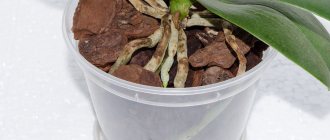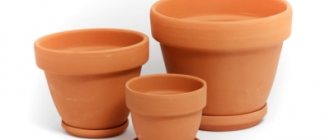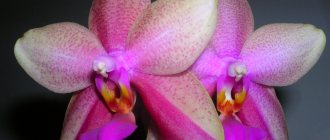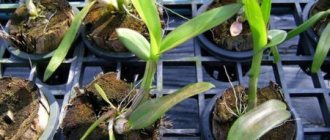Phalaenopsis is one of the most common varieties of orchids. It is considered unpretentious in comparison with other varieties, but if the flower is transplanted incorrectly, it can get sick or even die. The procedure is required in two cases: if the pot has become too small for the plant or the root system of the flower is damaged.
When is it right and how often is it required?
It is not recommended to replant the orchid immediately after purchase. As a rule, manufacturers add fertilizers to the substrate that are necessary for full development and flowering. This supply of nutrients will last for about a year. After this, the flower is replanted.
In addition, replanting is necessary if the pot has become too small for the plant. Phalaenopsis feels comfortable if only part of the roots are buried in the substrate, so it is better to choose a spacious container for the flower.
Usually, an orchid is transplanted into a new pot every 3-4 years.
When does a plant need replanting?
If the plant has a healthy root system, there is no suspicion of the presence of pests, and there are no signs of bark decomposition, then the plant should be replanted outside the flowering period in the spring. A clear sign of unsuitability of the substrate is the smell of mold. The bark needs to be replaced if, after watering, the flowerpot begins to weigh significantly more than before.
Reference. Under normal conditions, it is worth changing the pot to a larger one no more often than once every two years. The optimal period for transshipment is the time of active development of the root system and leaves. Usually such a breakthrough occurs after spring.
You should not disturb the phalaenopsis during flowering unless its condition requires an emergency transplant.
In winter, the plant enters a dormant period, the growth of the root system slows down significantly, and new leaves do not appear in the rosette. This time is not the best for transshipment. In summer, all the phalaenopsis's strength is spent fighting the hot and dry climate, so replanting can even destroy the flower.
Is it possible to replant a blooming orchid?
Transplantation is a serious stress for the plant, so it is not recommended to carry out the procedure during flowering.
But if rot has appeared on the roots or pests have settled on the flower, you cannot postpone planting it in a new container. If you wait until flowering is complete, the plant may die. Therefore, it is better to sacrifice one flowering period and plant the crop in a new container with fresh substrate to maintain its health in the future.
Read here how and when you can replant a flowering plant.
Flower location
Many gardeners are attracted to the phalaenopsis orchid. Care at home is quite simple; the most important thing is to strictly follow simple rules. An east or west window is most suitable for orchids. The flower requires shading in the summer. If the house has central heating, then you need to additionally use a humidifier, since in winter the orchid can suffer greatly. It is recommended to expand the window sill or cover the top of the heating radiator so that the heat from it does not spread to the flowers. An excess of natural light and a lack of it are harmful to the plant.
Priming
The soil for an orchid should consist of crushed tree bark with a small amount of charcoal, perlite and sphagnum moss. The amount of moss depends on the humidity level in the room. In most apartments the air is dry, so a third of the moss is added to the soil when planting. It absorbs water and gradually releases it to the roots.
Diseases and pests
It is important to find answers to many questions if you are planning to grow a phalaenopsis flower. How to care at home, how to deal with diseases and pests? We've already dealt with the first, it's time to move on to the second. The most common diseases are:
- bacterial leaf spot;
- powdery mildew;
- rot.
With bacterial spotting, an ulcer forms on the leaves, which is quite clearly visible. When pressed, liquid comes out. To treat, you need to cut off the damaged leaf and sprinkle the cut area with charcoal. If this does not help, you need to treat the plant with special preparations.
Powdery mildew is a fungal disease that resembles flour on leaves. This disease often appears when there is excessive humidity. Treatment is carried out with antifungal drugs.
Orchids are susceptible to rot caused by fungi and frequent watering of the plant. To treat, you need to completely remove the rotting areas and sprinkle these areas with charcoal. In addition, you need to change the soil and pour boiling water over the pot.
Knowing how to care for phalaenopsis, you can grow a healthy plant and ensure annual abundant flowering.
How should I choose another pot?
It is believed that phalaenopsis roots develop better in the light. For this reason, the crop is planted in a container made of glass or transparent plastic.
Advantage should be given to plastic containers: they are more stable and do not break if accidentally dropped.
Types and varieties of phalaenopsis
The genus Phalaenopsis includes more than 70 species (1) (some botanists will identify 77 species, but 7 of them are not officially approved - perhaps they are not separate species, but clones), is divided into 5 subgenera, two of which are sections (2). Most of them live in tropical rainforests, some grow on rocks, and others live in regions with dry or cold seasons. And this leaves its mark on agricultural technology.
In floriculture, all phalaenopsis plants are usually divided into 5 groups (2).
Phalaenopsis species. This includes natural species that have not been touched by selection. As a rule, they can be found among collectors; you are unlikely to find them on general sale.
Phalaenopsis stuartiana. Its leaves are variegated and its roots are silvery. The peduncle is long and branched (up to 80 cm), but there are a lot of flowers on it - sometimes up to 60 at a time. Delicate white flowers with red spots at the base; in the center of the flower there is an amber lip, gradually turning into purple.
Schiller's Phalaenopsis (Phalaenopsis schilleriana). Its leaves are beautiful, variegated - silver spots on a dark green background, the lower part of the leaf is red. The inflorescence is up to 50 cm, and a simply gigantic number of small (up to 7 cm in diameter) flowers are formed on it. In the right conditions, this orchid blooms in a beautiful, unique cascade.
Phalaenopsis amabilis. Large white flowers up to 10 cm in diameter, about 20 flowers develop on a peduncle. The leaves are fleshy and oblong. They form a rosette of 3 to 5 leaves. Flowers bloom one by one.
Phalaenopsis lueddemanniana. A beautiful orchid with hard paired leaves up to 25 cm long. Usually there are no more than 8 of them in a rosette. The flowers are white, like porcelain, with transverse stripes of violet, purple and chestnut shades. It smells very strong and pleasant!
Phalaenopsis cornu-cervi. Very impressive look. Its leaves are green, up to 22 cm long. The flowers are collected in peduncles of 12 flowers with a diameter of up to 4 cm, and they are of a very unusual color: yellow-green with red-brown transverse stripes. Moreover, they are also fragrant.
Phalaenopsis Stewart. Photo: pixabay.com
Phalaenopsis Schiller. Photo: pixabay.com
Phalaenopsis staghorn. Photo: pixabay.com
Large-flowered hybrids. This is a very large group; it is these phalaenopsis that are most often sold in garden centers. Neither are very unpretentious, even beginners can easily grow them.
There are a huge number of varieties in this group, which are usually divided according to flower color. In our stores, they usually do not indicate the names of the varieties; more often they write “mix” on the price tags, so Russian transcription has not come into practice. So here are their international names (if you search on the Internet, you may be able to determine which variety grows in your country).
White:
- Taisuco Crane;
- Taisuco Kochdian;
- Cygnus;
- Yukimai;
- Sogo Musadian;
- White Dream;
- Florida Snow.
Pink:
- Nobby's Pink Lady;
- Minho Valentine;
- Minho King Beauty;
- New Cinderella;
- Taisuco Firebird;
- Sogo Smith.
Semi-white (their upper and side petals are white, and their lips are colored):
- Lucia Lip;
- City Girl.
Striped:
- Sogo Zebra;
- Chih Shang Stripes;
- Okay Seven.
Spotted:
- Carmela Spots;
- Rousserole;
- Soroa Delight;
- Leopard Prince.
White phalaenopsis variety. Photo: pixabay.com
Semi-white phalaenopsis variety. Photo: pixabay.com
Variety of striped phalaenopsis. Photo: pixabay.com
Variety of spotted phalaenopsis. Photo: pixabay.com
New hybrids. For a long time, phalaenopsis were on sale exclusively in white and pink shades. However, now you can find yellow, orange, and red ones in garden centers. Such colors in industrial varieties appeared relatively recently - they began to be produced about 40 years ago. And some of them have become quite popular and can be found in our garden centers.
Yellow:
- Carol Campbell;
- Emil Giles;
- Brother Lawrence;
- Taipei Gold;
- Golden Bells;
- Sogo Manager;
- Brother Passat;
- Golden Amboin;
- Yellow Queen;
- Ching Her Buddha;
- Golden Sun
Orange (there are many shades here: copper, bronze, rusty red - these shades are often called desert or artistic):
- Sweet Memory;
- Zuma Aussie Delight;
- Pago Pago;
- Brother Sara Gold.
Reds (shades here range from orange-red to lavender-burgundy):
- Cordova;
- Lonnie Morris;
- Sogo Pony;
- Sogo Rose;
- Sogo Grape;
- Sogo Prince;
- Golden Peaker.
Harlequins. This is a completely new line that appeared in Taiwan - the flowers of these phalaenopsis are white or yellow with large almost black, like ink spots, which are randomly scattered across the petals.
The most famous varieties:
- Ever-Spring Light;
- Yu Pin Pearl;
- Yu Pin Panda;
- Bright Peacock.
Multi-flowered hybrids (multiflora). This group includes phalaenopsis with many flowers, which are located either on several peduncles or on one branched one.
Popular varieties:
- Be Glad;
- Cassandra;
- Vilind;
- Carmela;
- Zuma,
- Timothy Christopher;
- Be Tris;
- Quevedo.
Miniature hybrids. This is a relatively new line that was created by crossing various miniature Phalaenopsis species. And it is in this group that the most whimsical orchids are found, because their ancestors in the wild did not live in tropical forests, but in cool or dry regions. They have a dormant period, they need cooler growing conditions, in general - this is for experienced gardeners; it is better for beginners not to start them.
The most famous varieties in this group:
- Micro Nova;
- Mini Mark
- Anna-Larati Soekardi.
Instructions at home step by step
To make it easier to move the orchid to a new pot, we recommend using step-by-step instructions:
- The plant is carefully removed from the pot. To do this, its walls are slightly kneaded with your hands, and the substrate is watered generously. After this, the orchid can be easily pulled out of the pot along with the earthen lump. But if these manipulations do not help, it is better to carefully cut the wall of the container.
- The roots are washed under running water and cleared of any remaining substrate.
- The roots are carefully examined, all rotten and dry parts are removed. To identify the diseased root, you need to lightly squeeze it with your fingers. A healthy root is dense and hard, while diseased ones are usually hollow in the middle.
- All old yellow leaves are also cut off. After this, the plant is left outdoors for 2 hours to dry.
- Next, the flower is placed in a new container filled with fresh substrate. In this case, the roots should not be completely buried in the substrate. They take part in photosynthesis, absorb water and provide the plant with nutrients. Therefore, it is enough to immerse only a few roots in the soil to stabilize the plant, and the rest can be left outside.
How to carry out the procedure step by step?
To replant, you need to buy bark or a ready-made substrate, a new flowerpot, and charcoal in advance. If you suspect the presence of pests or a fungal disease, you should ensure that the appropriate chemicals are available.
Preparation
To transplant an orchid you will need:
- A new pot, which should be two fingers taller and wider than the previous container. For an orchid, it is better to choose a transparent flowerpot. This way the roots will receive the necessary sunlight, and the owner will be able to organize timely watering.
- Substrate for orchids or bark. The substrate can be made independently from sphagnum and pine bark.
- Stationery knife or scissors. Secateurs are also suitable for indoor flowers.
- Alcohol for disinfecting instruments.
- Charcoal for processing cuts.
Extraction from a flower from a pot
Remove the plant from the pot carefully. If the container was too small, the roots could grow into the drainage holes or become tightly attached to the soil (almost growing into it). It is better to place the pot with such a plant in a bowl of warm water for half an hour. The plastic container can be slightly dented before removing the plant.
You should remove the flowerpot as carefully as possible to injure the roots as little as possible and not break off the leaves. You need to take the orchid by the trunk with your hand, and then carefully remove the container with scrolling movements of the second hand.
Important! If the orchid pot is made of thin plastic, then it can be carefully cut with a stationery knife. This is the most gentle flower extraction.
Washing and inspection of the root system
- When the orchid is freed from the flowerpot, the root system must be cleared of old bark and moss.
If the plant has recently appeared in the house, then special attention should be paid to the presence of foam rubber, moss or bark under the root collar. Dense clumps of these materials allow stores to reduce the cost of caring for orchids. At home, such additions can lead to excessive waterlogging and death of the flower. Often among the roots you can see a plastic cup in which the orchid was grown. This element, if not removed in time, will also lead to the death of the phalaenopsis. - The next step is to wash the orchid roots for 20 minutes. During this time, the old substrate will soften and separate from the roots. If a piece of bark still does not come off, then it is better to leave it.
- After washing, you need to carefully examine the roots, leaves, and neck of the flower to identify problems.
What to do if pests and problems are found?
All rotten, dried ends of the roots are trimmed using pruners, a knife or scissors pre-treated with alcohol. It is worth removing the threads that are not covered with velamen. Fresh cuts are treated with charcoal.
- If pests are found during the transplantation process, the plant must be treated with an insecticide.
- If a fungal disease is detected, a fungicide must be used.
- If for some reason, when replanting a diseased flower in a pot, the same soil remains, then it must also be treated with the specified chemicals, but it is better in such cases to replace the bark completely.
Replanting into a new pot and soil
- A layer of drainage is placed at the bottom of the flowerpot.
- The bottom layer is covered with a small amount of substrate or bark.
- The orchid is taken by the trunk and placed in a pot on top of the bark. If in this position the root collar is below the level of the rim of the pot, then the plant is pulled out and more bark is added.
- Holding the phalaenopsis by the trunk, pour substrate on the sides, filling the entire space between the roots and the pot. When planting an orchid, you should not try to fit all the aerial roots into a container.
- If the orchid being transplanted had a peduncle, the last step is to strengthen the support for it and fix the arrow with a clamp.
In the video below you can see how to replant an orchid:
After care
It is extremely important to properly care for your orchid after transplantation to minimize stress:
- The first watering is carried out no earlier than 5 days after the procedure. The fact is that pathogens can get into wounds on the roots along with water.
- The plant itself is sprayed daily with water at room temperature.
- It is not recommended to fertilize the plant immediately after planting. The flower needs to adapt to a new place, so the first feeding is carried out no earlier than a month later.
After transplanting, a bamboo stick is installed in the new pot. It is needed to support the peduncle, since it can break under the weight of the buds.
Phalaenopsis flowering
There are also many specific subtleties in this issue. The phalaenopsis orchid is loved for its unusual, very beautiful flowering. Care at home, which complies with all the rules, will allow you to get many beautiful inflorescences. Many gardeners are concerned about how often a plant blooms and how many buds can be expected to form. After reproduction, the plant enters a dormant period, which can last 1-3 years, while roots and new leaves will gradually grow.
Without propagation, the orchid blooms approximately once a year for 3-6 months. And with good care of phalaenopsis at home, lush and fragrant inflorescences will last up to 12 months. However, flowering does not always indicate that the plant is healthy and the growing conditions are suitable for it.
It is quite easy to distinguish a healthy orchid. Normally, it should have 1-2 peduncles, on which 7-15 buds are formed, it all depends on the variety. If there are fewer inflorescences, then this may be a sign of a disease of the root system, which must be dealt with as quickly as possible, since the plant may die.
It is important to understand exactly how to care for a phalaenopsis orchid so that it delights with lush flowering. During this period, it is not recommended to change the position of the plant relative to the sun. The air should not be allowed to dry out, as this not only negatively affects flowering and leads to drying out of the soil, but also threatens the proliferation of parasites. In addition, you need to leave the orchid alone, as this flower does not like excessive care. It is not recommended to inspect the leaves every day, touch the bark or touch already flowering twigs with your hands.
There are also methods on how you can make an orchid bloom. These include:
- drought;
- temperature difference;
- use of hormonal paste.
Prolonged drying simulates the onset of critical and negative weather conditions for the plant. To do this, watering needs to be reduced by 2-3 weeks, and then again provide the flower with abundant moisture.
You can also lower the temperature at night by moving the plant to a glassed-in balcony. This is quite enough for the orchid to bloom. You can also apply cytokinin paste to the kidneys. Depending on the amount of the drug, a baby or even a new shoot with flowers may form.
Main reasons for transplantation
The plant can delight with its flowering for more than one year.
But suddenly you notice that the orchid does not throw out as many flower stalks as before, the flowers lose their former decorativeness.
At this moment it is worth thinking about the reasons .
Perhaps the phalaenopsis is already quite cramped in the previous flowerpot. The roots can squeeze the substrate out of the pot and crawl out on top of the soil themselves. The reason lies in the formation of a large number of roots and an urgent transplant into a larger pot is required.
Substrates for phalaenopsis can be different in composition:
- Bark, for example, can exist without replacement for up to three years , which cannot be said about the presence of moss as the main component;
- In this case, the soil is changed after 2 years.
The reason here lies in the loss of vital characteristics for the flower:
- Loss of breathability;
- Mineral salts lose balance;
- The acidity level changes.
If such changes are present, a good time for replanting is spring , when the plant is in an active growth phase.
Sometimes an immediate transplant without waiting for favorable conditions.
The reason is as follows:
- Phalaenopsis was attacked by pests;
- The soil has lost its appearance due to waterlogging, and the roots are rotting;
- Flower disease.











